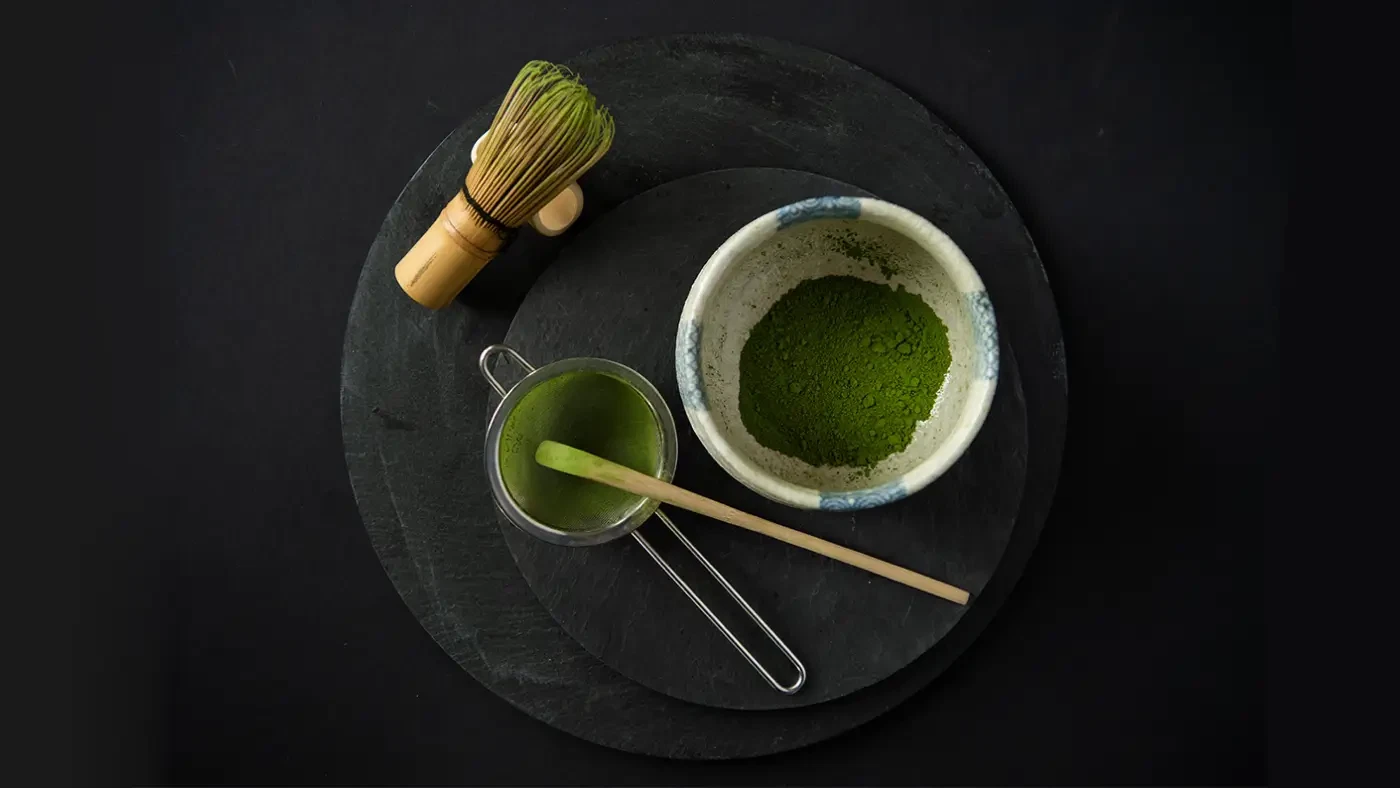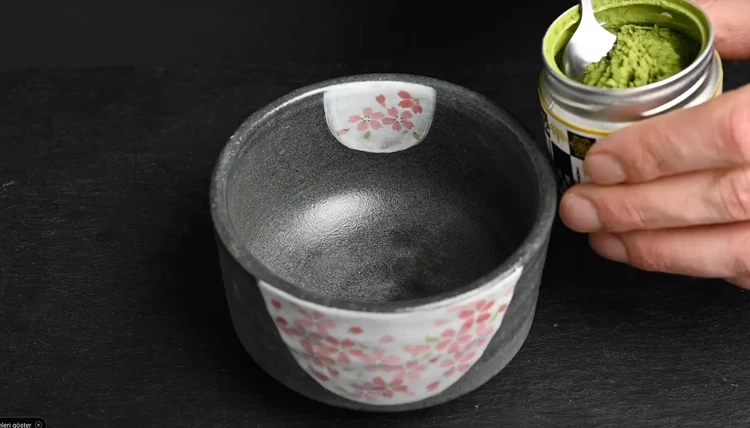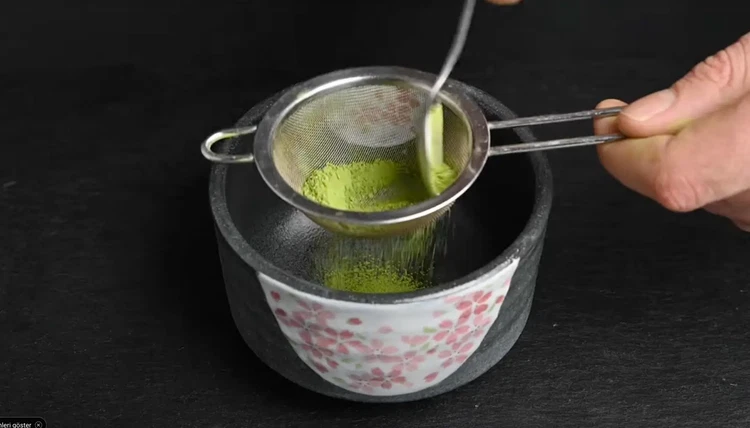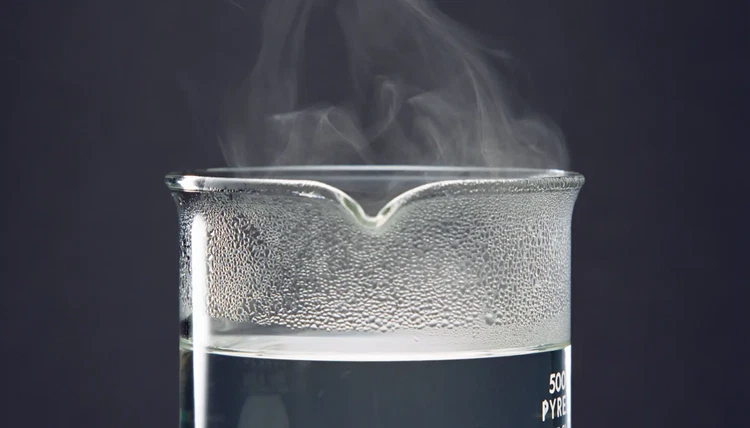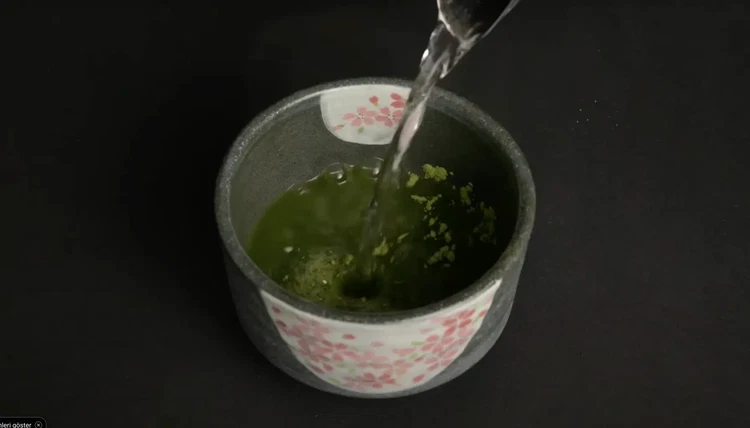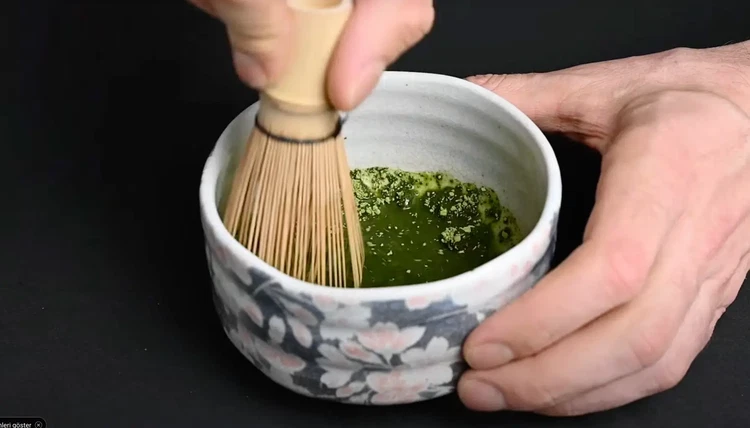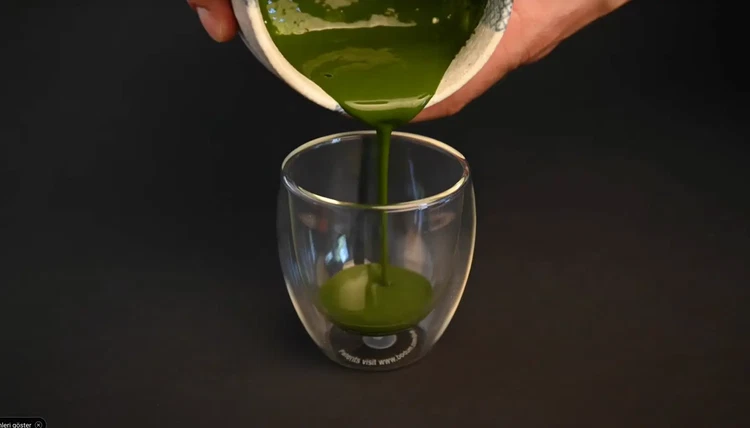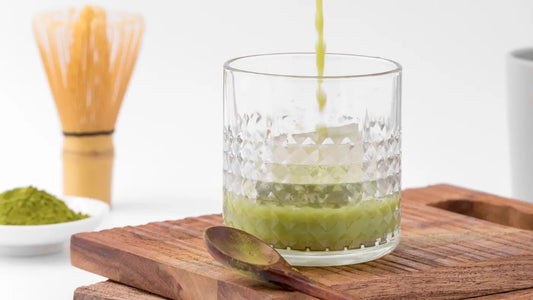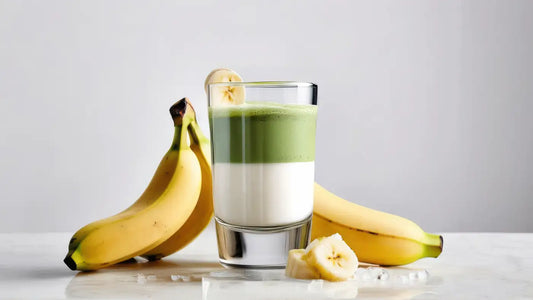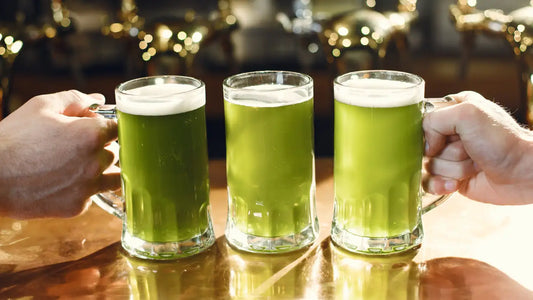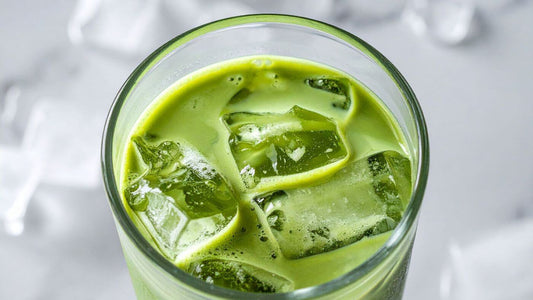Preparazione cerimoniale del matcha può essere un'esperienza divertente e gratificante se si riesce a impararla. Se chiedete a qualsiasi bevitore di matcha, bere il tè matcha è solo metà del processo, l'altra metà è la preparazione ritualizzata del matcha. Questa è una reliquia della cerimonia del tè giapponese, da cui deriva il termine matcha cerimoniale preparazione . In questo articolo, vi insegneremo qualcosa in più su come preparare il matcha cerimoniale e cosa potreste voler considerare prima di prepararlo in casa.
Quali sono le diverse fasi della preparazione del matcha cerimoniale?
In questa sezione impareremo come preparare il matcha cerimoniale. Seguendo queste istruzioni passo dopo passo, dovrebbe essere facile preparare una ciotola di tè matcha dal gusto eccezionale. Senza ulteriori indugi, iniziamo a mescolare 🍵🍃
Misurare

La prima cosa da considerare quando si tratta di preparazione del matcha cerimoniale sono le misurazioni.
Sebbene sia consigliabile utilizzare uno strumento di misurazione come una bilancia o un cucchiaio dosatore, questo non sarà sempre necessario, soprattutto dopo aver preparato il tè matcha per molto tempo.
Prima di iniziare a seguire i passaggi su come preparare il matcha cerimoniale, ti consigliamo di imparare le dosi di 1 cucchiaino di polvere di matcha e circa ½ tazza d'acqua. Questa dovrebbe essere una proporzione ideale per preparare una normale tazza di tè matcha.
Setacciare
Dopo la misurazione, il primo vero passaggio di come preparare il matcha cerimoniale riguarda la setacciatura. Anche se questo passaggio potrebbe non essere del tutto necessario, fa davvero la differenza quando si tratta di preparare una tazza di tè matcha dal gusto eccezionale. Non appena si apre la lattina e la polvere di matcha viene esposta all'umidità dell'aria, inizierà a formare dei grumi. Questi grumi non significano che il matcha sia andato a male, ma impediranno che si mescoli in modo uniforme con l'acqua, quindi è necessario rimuoverli.
Il modo migliore per farlo è passare la polvere attraverso un setaccio prima di preparare il matcha cerimoniale. Basta posizionare il setaccio sopra la ciotola del matcha e aggiungere 1 cucchiaino di polvere di matcha. Successivamente, puoi semplicemente passare il matcha attraverso il setaccio e i grumi saranno eliminati.
Riscalda l'acqua e versa
Una volta che la polvere finemente setacciata sul fondo della ciotola del matcha, sei pronto per passare alla fase successiva di come preparare il matcha cerimoniale. Ora puoi versare l'acqua e prepararti a mescolarla con la polvere. Per quanto riguarda l'acqua, si consiglia di utilizzare 120 ml (circa mezza tazza) di acqua con una temperatura compresa tra 60 e 75 gradi Celsius. A differenza dei tè in foglie, il matcha non si "infonde", quindi la temperatura è meno importante, ma predilige comunque una temperatura compresa in questo intervallo. Se si usa acqua troppo calda, il tè può diventare amaro, mentre se si usa acqua troppo fredda, sarà più difficile mescolare la polvere con l'acqua.
Sbattere

Una volta aggiunta l'acqua calda alla polvere, si è pronti per passare alla fase più nota della nostra guida su come preparare il matcha cerimoniale sbattere. Si può iniziare mescolando delicatamente la polvere di matcha nell'acqua, assicurandosi che sia completamente amalgamata. Si può iniziare raschiando i lati della ciotola e poi il fondo. È importante farlo con molta delicatezza perché la frusta per matcha può essere piuttosto fragile e tende a rompersi se la si strofina troppo forte contro i lati.
Successivamente, puoi iniziare a creare la schiuma mescolando il tè matcha con il polso con movimenti a zigzag. Questa tecnica richiede molto tempo per essere padroneggiata, ma una volta acquisita la giusta padronanza, ci vorranno solo circa 30 secondi per ottenere una bella schiuma sulla superficie. Questa schiuma non è solo estetica, ma conferisce anche al tè un gusto più morbido e cremoso.
Servire e gustare
L'ultimo passaggio di come preparare il matcha cerimoniale è servire e gustare il tè matcha. Il modo tradizionale di gustare il tè matcha è semplicemente berlo direttamente dalla Ciotola per Matcha. Questo è il modo in cui si fa durante la cerimonia del tè giapponese e può essere una bella tradizione da integrare nel tuo Preparazione cerimoniale del matcha rituale.
Se preferisci bere il matcha nei bicchieri, puoi versare il tè dalla ciotola nei bicchieri e dividerlo tra te e il tuo ospite. In questo caso, potresti preferire versare il tè sopra il lavandino o mescolarlo con un beccuccio, in modo da poterlo versare più facilmente senza sporcare.
Attrezzatura necessaria per la preparazione cerimoniale del matcha:
Altrettanto importante come preparare il matcha cerimoniale è cosa Teiera giapponese da usare. Di seguito abbiamo stilato un elenco di tutto ciò che ti servirà per il tuo Preparazione cerimoniale del matcha senza un ordine particolare. Ti mostreremo anche dove puoi trovare questi strumenti se non li hai già a casa.

matcha cerimoniale
Ovviamente non puoi nemmeno iniziare la tua Preparazione cerimoniale del matcha senza la polvere di matcha stessa. Quando bevi il matcha puro in questo modo, è importante scegliere un prodotto di qualità superiore. Consigliamo un matcha okumidori super cremoso come il matcha washimine o il matcha Nakai Superior. Usando tè matcha in questo modo, ridurrai notevolmente l'amaro del tuo tè matcha.
Frusta per matcha

Lo strumento più iconico e importante di Preparazione cerimoniale del matcha è il frullino per il matcha. Questo frullino in bambù, chiamato anche chasen, è realizzato con un unico pezzo di bambù e le 100 piccole setole si muovono nell'acqua per aerare il tè e creare quella bella schiuma in superficie.
Se stai pensando di acquistare un unico strumento per la preparazione del matcha, ti consigliamo vivamente di scegliere questo. Il frullino per il chasen è lo strumento più difficile da sostituire.
Chawan - Ciotola per il matcha

Il prossimo strumento per Preparazione cerimoniale del matcha è la ciotola per il matcha in argilla, o chawan. La chawan è ciò che viene utilizzato durante la cerimonia del tè per preparare il matcha per gli ospiti. Di solito presenta un bellissimo motivo sul lato, che è pensato per essere rivolto verso gli altri ospiti in modo che possano ammirare la parte più bella della ciotola mentre si beve.
Questo rafforza il principio di "rispetto", uno dei 4 principi chiave della cerimonia del tè giapponese. Se desideri saperne di più sulla ciotola, puoi leggere la guida completa che abbiamo creato. 👉 Scopri tutto quello che devi sapere sul Matcha Whisk
La ciotola per il matcha chawan è realizzata in argilla spessa e pesante. Questo ha lo scopo di trasmettere un senso di importanza, poiché richiede a chi beve il matcha di tenerla con entrambe le mani. Questo concentra l'attenzione lontano dalle distrazioni e sul tè stesso. L'argilla spessa trattiene bene il calore e mantiene il tè caldo a lungo. Il maestro del tè preriscalda l'argilla prima di preparare il tè per garantire che il matcha rimanga caldo.
Infine, il design della ciotola per il matcha chawan è più cilindrico. I bordi alti della ciotola facilitano la preparazione del tè senza rovesciarlo. Avere questa ciotola è un passaggio fondamentale.Come preparare il matcha cerimoniale.
Setaccio
Un altro strumento di cui si parla raramente per Preparazione cerimoniale del matcha è il setaccio o furui. Questo strumento non è presente nella cerimonia del tè, poiché la polvere di matcha viene spesso setacciata in anticipo. Questi strumenti sono abbastanza facili da trovare e possono fare in modo che il matcha si mescoli in modo molto più uniforme con l'acqua. Se vuoi davvero portare il tuo Preparazione cerimoniale del matcha a un livello superiore, ti consigliamo di procurartene uno.
Come preparare il matcha cerimoniale senza frusta?
Sebbene la frusta chasen per matcha sia lo strumento migliore per preparare il tè matcha, se non ne hai una non dovrebbe essere una scusa per non preparare deliziose ciotole di matcha cerimoniale. Esistono diversi strumenti che possono funzionare, e ognuno ha i suoi vantaggi e svantaggi. Prima di entrare nei dettagli, guarda il nostro video completo sull'argomento proprio qui. 👇
Capsulone montalatte
Un capsulone montalatte è un buon sostituto, ma può costare quanto, se non di più, di una frusta di bambù e non funziona altrettanto bene. Se ne hai uno a casa, dovresti usarlo al posto della frusta, ma se non ne hai uno è meglio investire nel chasen.
Un barattolo
Puoi anche shakerare il matcha in un barattolo per prepararlo. Questa tecnica è ottima per creare la schiuma sulla superficie del matcha, ma può creare un matcha con molti grumi, poco piacevole da bere. Se lo prepari Preparazione cerimoniale del matcha in uno shaker, assicurati di non saltare la fase di setacciatura!
Frusta di metallo
Infine, puoi usare una frusta di metallo, ma non è efficace quanto quella di bambù. Le setole di metallo tagliano l'acqua e non arieggiano il tè altrettanto bene. Inoltre, creano un rumore fastidioso che può disturbare il tuo silenzioso rituale di preparazione del matcha. Ecco perché, quando si tratta di Preparazione cerimoniale del matcha, è meglio attenersi alla tradizionale frusta di bambù.
Quali sono le diverse qualità di matcha?
Esistono diverse qualità di polvere di matcha e, come noterai prima di iniziare questa guida su come preparare il matcha cerimoniale, ci siamo assicurati di specificare che dovresti usare solo polvere di matcha di prima qualità, come spiegheremo di seguito.
Matcha di qualità cerimoniale
Questo matcha è di qualità superiore ed è pensato per essere consumato puro, senza latte né zucchero. Ci sono molti passaggi nel processo di produzione che rendono il tè naturalmente morbido e dolce. Se questi passaggi vengono saltati, si otterrà un matcha dal sapore amaro che dovrà essere mescolato con latte o zucchero per essere bevuto. Quando si tratta di Preparazione cerimoniale del matcha, è fondamentale utilizzare questa polvere di alta qualità.
Matcha di qualità Latte
Il matcha di qualità Latte è in genere prodotto da un raccolto tardivo e può essere un po' troppo amaro per preparare il matcha cerimoniale. Questo matcha è migliore servito come matcha latte al tè verde, mescolato con latte di soia e un po' di dolcificante. Poiché il matcha di qualità latte è prodotto da un raccolto tardivo, oltre ad avere un sapore più amaro, avrà anche un contenuto inferiore di nutrienti e caffeina.
Matcha di qualità da cucina
Cucinare e cuocere al forno dovrebbe essere fatto solo con la polvere di matcha di qualità più bassa. Questi tè matcha di qualità da cucina sono molto amari, ma funzionano benissimo se combinati in una ricetta che include molti altri ingredienti come Brownies al matcha ad esempio. Il vantaggio di questo matcha è che è così economico che puoi usarne qualche cucchiaio qua e là senza spendere troppo.
Qual è la differenza tra Usucha e Koicha?
Esistono due diversi stili di preparazione del matcha, entrambi utilizzabili nella cerimonia del tè giapponese. Il primo è il più comune ed è l'usucha, ovvero il tè leggero. Il secondo, utilizzato in cerimonie del tè speciali, è il koicha, ovvero il matcha denso.
Come preparare l'Usucha ("tè leggero")
- Passaggio 1: Posizionare il setaccio sopra una ciotola
- Passaggio 2: Aggiungere 1 cucchiaino di matcha al setaccio
- Passaggio 3: Spingere la polvere attraverso il setaccio per eliminare i grumi
- Passaggio 4: Aggiungere acqua nella ciotola quanto basta per formare una pasta (questo rende ancora più facile assicurarsi che non ci siano grumi)
- Passaggio 5: Aggiungere 58 ml di acqua nella ciotola (85 °C)
- Passaggio 6: Sbattete il tè. Iniziate eliminando i residui dai lati e poi sbattete fino a creare una schiuma.
Come preparare il Koicha ("tè denso")
- Passaggio 1: Posizionare il setaccio sopra una ciotola
- Passaggio 2: Aggiungere 2 cucchiaini di matcha al setaccio
- Passaggio 3: Spingere la polvere attraverso il setaccio per eliminare i grumi
- Passaggio 4: Aggiungere 58 ml di acqua nella ciotola (85 °C)
- Passaggio 5: Mescolare la polvere e l'acqua nella ciotola fino a ottenere una pasta densa. Assicurarsi di raschiare completamente i lati della ciotola.
- Passaggio 6: Bevi la pasta di matcha
Scegliere un Matcha
Quando si tratta di scegliere un tè matcha, tutto dipende dall'uso che intendi farne. Se intendi preparare il matcha semplice, solo con acqua, ti consigliamo di dare un'occhiata ad alcuni dei nostri matcha di qualità cerimoniale. Dopo aver viaggiato per il Giappone negli ultimi anni, abbiamo incontrato decine di coltivatori e provato centinaia di tè matcha diversi. Abbiamo selezionato i più saporiti che abbiamo trovato e possiamo condividerli con te sul nostro sito web nioteas.com. Questi matcha di alta qualità saranno i migliori per Preparazione cerimoniale del matcha.
Se sei più un fan del matcha latte, abbiamo un ottimo matcha di qualità latte che puoi provare. Questo è del signor Masuda, un talentuoso coltivatore di Shizuoka. Anche se questo matcha è un po' più amaro, è coltivato con amore e cura, senza pesticidi. Ogni volta che bevete il matcha, anche se lo usate per preparare un latte macchiato, è importante che sia ottenuto da una polvere di matcha coltivata senza pesticidi.

